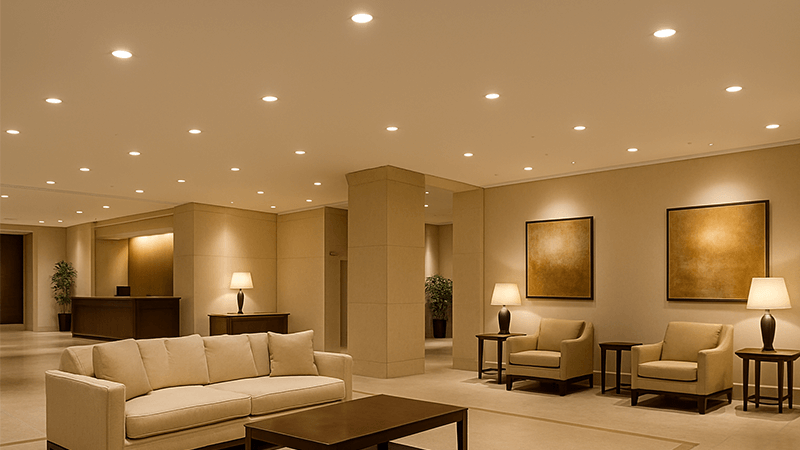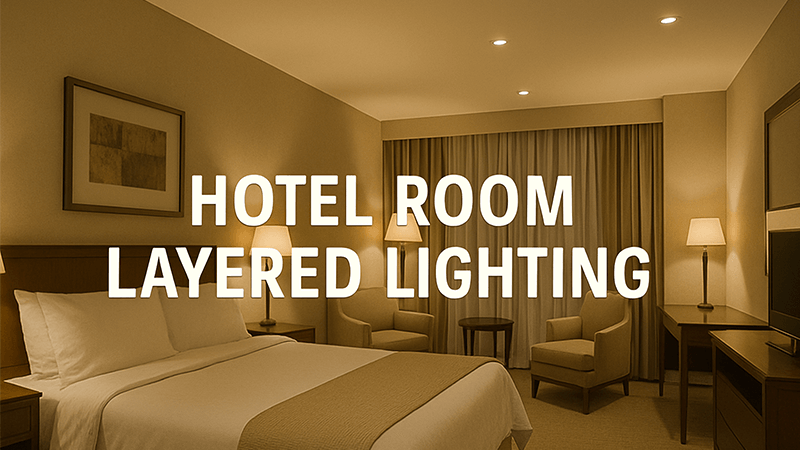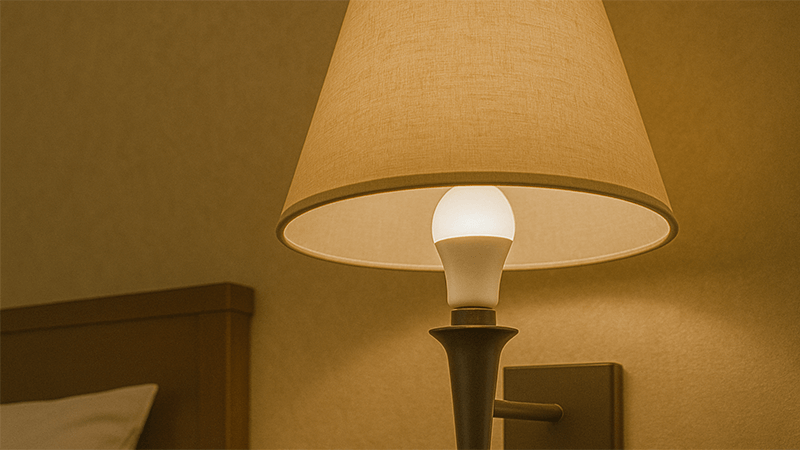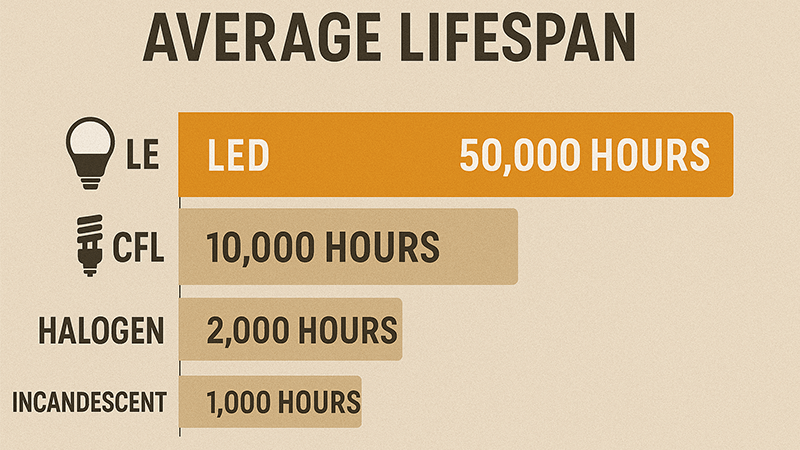Battling high energy bills and relentless lighting maintenance in your hotel? Outdated fixtures can hurt your budget and guest experience. It's time to consider why modern hospitality design is changing.
Hotels overwhelmingly prefer LED downlights for their superior energy efficiency, long lifespan, and excellent light quality. They significantly reduce operational costs, minimize maintenance, and provide versatile, dimmable lighting to create the perfect guest ambiance.

In my years in the lighting industry, I've seen trends come and go. But the move towards LED downlights1 in hotels isn't just a trend; it's a smart business decision. It's about creating a memorable experience for guests while also being incredibly practical from an operational standpoint. The right lighting can transform a space from simply being a room to being a destination. But how do different lighting types come together to create this effect, and why do downlights play such a starring role? Let's explore the strategy behind modern hotel lighting.
What type of lighting is used in hotels?
Confused by the different lights you see in a hotel? A jumble of fixtures can look messy and fail to create a cohesive atmosphere. This can make a space feel unplanned and unwelcoming.
Hotels use a layered lighting strategy2 combining ambient, task, and accent lighting3. Ambient lighting provides overall illumination, task lighting4 focuses on specific areas like desks, and accent lighting highlights features like artwork or architecture.

When I work with a hotel client like Shaz, a Purchasing Manager in the UAE, the first thing we discuss is the 'feel' they want to create. This isn't achieved with just one type of light. We use a method called layered lighting. It’s about combining different light sources to build depth, mood, and functionality. Think of it like painting a picture, but with light.
The Three Layers of Hotel Lighting
- Ambient Lighting: This is the general, foundational light of a room. It's often soft and diffused. In hotels, this is most commonly achieved with recessed LED downlights, which provide a clean, modern look without cluttering the ceiling.
- Task Lighting: This is focused light for specific activities. A desk lamp for working, a reading light by the bed, or vanity lights around a bathroom mirror are all examples. It’s about providing clear, bright light exactly where it's needed.
- Accent Lighting: This is the dramatic layer. It’s used to draw attention to architectural details, artwork, or textures. Wall sconces, track lights, and uplights are often used for this purpose.
Here’s how these layers apply across different hotel zones:
| Hotel Area | Ambient Lighting | Task Lighting | Accent Lighting |
|---|---|---|---|
| Lobby | Recessed LED Downlights | Lighting over reception desk | Spotlights on artwork or plants |
| Guest Room | Recessed LED Downlights | Bedside reading lamps, desk lamp | Sconces or lights highlighting a feature wall |
| Restaurant | Dimmable LED Downlights | Pendants over tables | Track lights on a bar or menu board |
By using this approach, a hotel can create a space that is not only beautiful but also highly functional for its guests.
Why do most hotels not have ceiling lights?
Walking into a hotel room with a single, harsh ceiling light feels cheap and clinical. It casts unflattering shadows and offers no sense of luxury or comfort, ruining the guest's first impression.
Most hotels avoid central ceiling fixtures to create a warmer, more sophisticated ambiance. Instead of one harsh light source, they use multiple recessed downlights and lamps to create soft, layered pools of light that feel more residential and luxurious.

When I was starting out, I visited a hotel that had just installed new lighting. They chose a single, powerful ceiling fixture for the center of each room. The result was a disaster. The light was harsh, it created unflattering shadows on people's faces, and the room felt more like an office than a retreat. This experience taught me a valuable lesson: how you deliver the light is as important as the light itself. Hotels have learned this and now intentionally design their lighting to avoid this exact problem.
The Problem with Single-Source Lighting
A single central fixture, often called a "builder-grade" light, creates a flat and uninviting space. It illuminates everything equally, which means nothing is emphasized. This approach lacks sophistication and fails to create the relaxing, upscale atmosphere that modern travelers expect. It’s the fastest way to make an expensive room feel cheap.
The Power of Recessed Downlights
This is where LED downlights become the hero. Instead of one source, designers use several downlights strategically placed around the room. This allows them to:
- Create Ambiance: They produce pools of light, creating a rhythm of light and shadow that adds depth and interest.
- Guide the Way: Paths of light can guide guests from the door to the bed or sitting area.
- Maintain Clean Ceilings: The fixtures are flush with the ceiling, giving a clean, minimalist look that makes rooms feel larger and more modern.
However, choosing the wrong downlights can be a huge mistake. I had a client who sourced cheap downlights to save money. During installation, the poor-quality spring clips were so stiff and sharp that they scratched and tore the new plasterboard ceilings in dozens of rooms. Even worse, when a unit failed a year later, the clips had rusted, making them nearly impossible to remove without causing more damage. This is a classic example of how a low price always means cutting corners somewhere. A good downlight is designed for easy, damage-free installation and removal.
Do hotels have LED lights?
Flicking on a light in a hotel room and having it slowly flicker to life or cast a yellowish, dim glow is frustrating. Old CFL or halogen bulbs are inefficient, run hot, and have poor light quality.
Yes, almost all modern and renovated hotels use LED lights extensively. The switch is driven by massive energy savings, extremely long lifespan5s that reduce maintenance, and superior lighting quality and control that enhances the guest experience6.

The shift to LED technology7 has been one of the biggest revolutions I've seen in my career. I remember talking to a hotel purchasing manager about ten years ago. He was skeptical about the high upfront cost of LEDs compared to the cheap CFL bulbs he was buying in bulk. To convince him, I didn't just talk about features; I showed him the numbers. I created a simple spreadsheet showing his current electricity and replacement costs versus the cost of an LED retrofit.
The ROI of Switching to LED
I laid it all out for him. The LEDs were more expensive to buy, yes. But they used 80% less energy and lasted 15 times longer.
- Energy Savings: The reduction in his monthly electricity bill was immediate and significant.
- Maintenance Savings: He was replacing CFLs constantly. His maintenance team was on a near-permanent cycle of changing bulbs across hundreds of rooms. The long lifespan of LEDs (often 50,000 hours) meant this cost would virtually disappear for years.
- HVAC Savings: I also pointed out something many people forget. Incandescent and halogen bulbs produce a lot of heat. In a hot climate like the UAE, that means the air conditioning has to work harder to compensate. LEDs run much cooler, leading to secondary savings on cooling costs.
When he saw the total cost of ownership8, he was stunned. The payback period for the entire LED investment was less than two years. After that, it was pure savings. Needless to say, he became a convert. Today, it’s not a question of if a hotel will use LEDs, but which LED solution is best for them.
Why is LED more preferred?
You've been told a cheap lighting fixture is "good enough," but then you face constant failures and budget overruns. The initial low price is tempting, but the long-term headaches and costs can cripple an operation.
LED lighting is preferred because it offers the best overall value. Beyond just energy savings, LEDs provide superior reliability, design flexibility, and light quality. This reduces total cost of ownership and creates a better, more consistent guest experience.

For a purchasing manager like Shaz, the ultimate goal is to secure the best value for his projects. It’s not just about the price on the invoice. Value is a combination of price, performance, and reliability over the long term. This is where LEDs truly outshine every other technology on the market, but it's also where you have to be the most careful as a buyer.
Price vs. True Value
I always tell my clients a simple truth: a high price doesn't guarantee 100% quality, but a very low price absolutely guarantees that corners were cut somewhere. The unseen components of an LED downlight—the driver, the heat sink9, the LED chip itself—are what determine its lifespan and performance. A cheap product will use inferior versions of all three, leading to flickering, poor color, and early failure. What you save on day one, you will pay for five times over in replacement and labor costs.
The Sample vs. Bulk Order Trap
Another critical point I stress is the difference between a sample and a bulk production run. I've seen it happen many times. A supplier sends a beautiful, perfectly functioning sample. It feels heavy, the light is perfect, and it passes all your tests. You're impressed and place a large order. But when the container arrives, the quality is completely different. The fixtures feel lighter, the color of the light varies from one unit to the next, and the failure rate is high. This happens because the sample was "cherry-picked" or specially made, while the bulk order was produced with lower quality control10 to save money. This is why working with a trusted manufacturer with a transparent production process is non-negotiable. At my company, we welcome clients to inspect the production line because we stand by our consistency.
| Feature | Inexpensive LEDs | Quality LEDs |
|---|---|---|
| Driver | Low-quality, prone to causing flicker and early failure | Isolated, stable driver ensuring consistent, flicker-free light |
| Heat Sink | Undersized or thin aluminum, poor heat dissipation | Substantial, well-designed heat sink for long chip life |
| LED Chip | Low-grade chip with poor color accuracy11 (low CRI) | High-quality chip from a reputable brand (high CRI >90) |
| Long-Term Cost | High due to frequent replacement and labor | Low due to long lifespan and minimal maintenance |
Conclusion
Choosing LED downlights is a strategic decision for hotels, balancing guest experience with operational efficiency. They offer unmatched value through energy savings, low maintenance, and superior ambiance, defining modern hospitality lighting.
Explore how LED downlights can enhance energy efficiency and guest experience in hotels. ↩
Explore the concept of layered lighting and its impact on hotel design and guest experience. ↩
Find out how accent lighting can highlight architectural features and artwork in hotels. ↩
Discover how task lighting enhances functionality in hotel rooms and common areas. ↩
Discover why the long lifespan of LEDs is crucial for hotel maintenance and cost savings. ↩
Understand the critical role of lighting in shaping a memorable guest experience. ↩
Explore the benefits of LED technology for energy savings and improved lighting quality. ↩
Learn how total cost of ownership affects lighting decisions in the hospitality industry. ↩
Learn about the importance of heat sinks in ensuring the longevity of LED lights. ↩
Discover how quality control impacts the reliability and performance of hotel lighting. ↩
Explore why color accuracy is essential for creating the right atmosphere in hotel spaces. ↩

